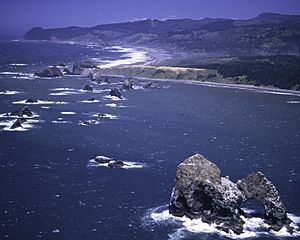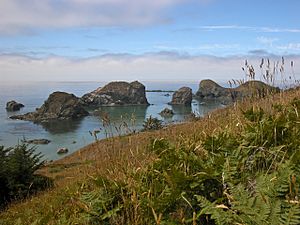Oregon Islands National Wildlife Refuge facts for kids
Quick facts for kids Oregon Islands National Wildlife Refuge |
|
|---|---|
|
IUCN Category IV (Habitat/Species Management Area)
|
|

Haystack Rock at Cannon Beach
|
|
| Location | Oregon |
| Area | 1,083 acres (438 ha) |
| Created | 1935 |
| Governing body | United States Fish and Wildlife Service |
| Website | Oregon Islands NWR |
The Oregon Islands National Wildlife Refuge is a special place along the coast of Oregon. It's a protected area made up of many small islands, rocks, and two headlands. These places are super important for wild animals, especially birds and marine mammals. The refuge stretches along most of Oregon's coastline, from the border with California all the way up to Tillamook Head. It helps keep these natural homes safe for wildlife.
This refuge is part of a bigger group called the Oregon Coast National Wildlife Refuge Complex. It includes 1,853 small islands, rocks, and reefs. It also protects two pieces of land that stick out into the ocean. The refuge covers about 1,083 acres along Oregon's coast. You can find parts of it in six of Oregon's seven coastal counties. These are Clatsop, Tillamook, Lincoln, Lane, Coos, and Curry counties.
Contents
A Look Back: How the Refuge Started
The Oregon Islands National Wildlife Refuge was created in 1935 by the U.S. government. This means the country decided to protect these islands. In 1968, Haystack Rock near Cannon Beach was added to the refuge. Later, in 1978, it became a special "wilderness area." This means it's kept as wild as possible.
The first part of the refuge on the mainland (not an island) was added in 1991. This was Coquille Point, which is near Bandon. In 1999, an oil spill happened near Coos Bay. This event sadly harmed some of the birds living in the refuge.
Amazing Wildlife of the Oregon Coast
This refuge is a safe home for many nesting seabirds. Thirteen different kinds of seabirds come here to lay their eggs and raise their young. It's one of the most important places for seabirds in the United States. Over 1.2 million individual birds nest here! That's more than on the coasts of California and Washington combined.
Some of the most common birds you might see here are:
- Common murres
- Tufted puffins
- Rhinoceros and Cassin's auklets
- Pigeon guillemots
- Leach's storm-petrels
- Several types of gulls
- Caspian terns
Marine Mammals: Seals and Sea Lions
Four kinds of pinnipeds also use these lands. Pinnipeds are marine mammals like seals and sea lions. They use the refuge to breed, rest, and shed their fur. These animals include:
The southern part of the refuge is especially important for Steller sea lions. It has the most places for them to breed and have their pups outside of Alaska.
Visiting the Refuge: What You Need to Know
Most of the islands in the refuge are closed to people. This is to protect the sensitive wildlife that lives there. The only exception is Tillamook Rock Light and the small rock around it.
If you are on a boat, you must stay at least 500 feet away from the islands. Airplanes should also stay at least 2,000 feet above the refuge. This helps keep the animals from being disturbed.
Even though you can't go on the islands, you can still see the amazing wildlife! There are great viewing spots from the mainland. One good place is Coquille Point in Bandon. You can also find other suggested viewing spots on the Oregon Coast Birding Trail.
The United States Fish and Wildlife Service manages and takes care of this special area.



